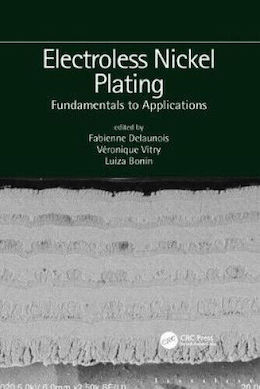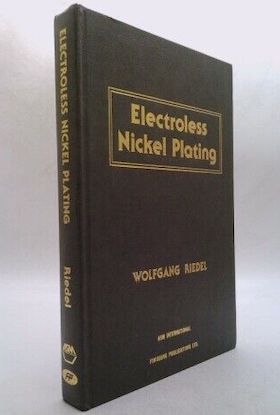
Curated with aloha by
Ted Mooney, P.E. RET

The authoritative public forum
for Metal Finishing 1989-2025

-----
Electroless Nickel with PTFE Plating Problems
Q. How to consistently process ENPTFE parts on low carbon steel?
We are facing the following issues:
1. Black patches
2. White patches
3. Small blisters
- Bangalore
September 9, 2024
⇩ Related postings, oldest first ⇩
Q. Presently I do nickel/teflon plating on small cylindrical parts. The plating is deposited all over with a .0002" thickness. The inside diameter varies between .047" to .090". The parts are made of 440C stainless steel and are subject to approx. 500 °F heat. The plating keeps peeling off from the inside diameter.
Lou Carozza- Miami, Florida
2005
by Fabienne Delaunois et al

on eBay or
AbeBooks
or Amazon
(affil links)
A. My guess is you are not getting enough solution flow in that tiny ID for it to get clean or properly activated. I also doubt if you are getting much nickel plate in it either.
James Watts- Navarre, Florida
A. Hi,
Well, your information is sparse. The surface which peels off, is it brittle? How do you plate the parts (racks, barrel etc.)?
Regards,
Dominik Michalek- Mexico City, Mexico
A. 400SS as well as other series and tool steels have to be activated first in a high acidic chloride electrolyte before EN plating. This initial process is electrolytic as well as other prior cleaning steps, thus dependent on electrochemical laws, one of which indicates that very little or no current (therefore very little or no effect) will get into an inside diameter. This in turn means that, although EN will penetrate, it might plate on top of a surface that is not properly cleaned or activated. Few alternatives apart from selecting another base steel to my point of view.
Guillermo MarrufoMonterrey, NL, Mexico
A. What is your cleaning process and what state is the stainless steel in? Has it been heat treated prior to plating? How are you plating the ID? What are your plating conditions? From the information you have given, I would initially think the problem could be inadequate cleaning or an incorrect current density. Have you considered electroless nickel/PTFE?

Trevor Crichton
R&D practical scientist
Chesham, Bucks, UK
How to mix PTFE into an EN plating bath
Q. Hello,
We have some PTFE that we try to mix in our EN bath, but the PTFE just floats on top of the bath. how should we mix the PTFE? should we add some chemicals to the bath?
Thanks!
plating shop employee - Philippines
2007
A. Personally, I think you should buy (or license) a process for teflon impregnated electroless nickel, Gilbert. I think there is a very long road between EN and teflon impregnated EN, but let's see what others say. Good luck.

Ted Mooney, P.E.
Striving to live Aloha
finishing.com - Pine Beach, New Jersey
|
A. For the "impregnated" material, you need to go to a proprietary material to avoid the problems that you are having. They did a lot of research to come up with a way to make it neither float or sink.
James Watts - Navarre, Florida A. I think Ted is right. There are a number of patents in the field that have been vigorously defended. Even if you were to formulate your own bath you might be in violation and open to a law suit. Gene Packmanprocess supplier - Great Neck, New York |
Q. Hi from Spain,
I have a problem with a bath of electroless nickel PTFE. The coating is OK, but I can't eliminate the powder of PTFE that settles on the parts after the bath.
Normally this is not a problem, but I have a new parts from a new client that requires the eliminate of this precipitate. Now this parts are being covered by other supplier that is capable of eliminating this precipitate.
Sorry for my poor english. I hope that the problem is understood well. Thanks for your prompt answers.
- Valencia, Spain
June 13, 2013
Q. Does anyone have experience in setting up Teflon EN? We are using chemicals supplied by our regular EN supplier. Like most typical EN tanks, the Nickel and Hypophosphite components are mixed together, then once we get the bath up to operating temp, we add the Teflon that comes separate to the bath after shaking it vigorously. We are only using a 60-gallon tank, so it's rather small compared to our regular 160 and 310 gallon EN tanks. Tank runs at 185 °F per the TDS with a pH of 5. Solution is technically a High Phos EN with PTFE added.
My main questions concern filtration or solution flow. What is the recommended practice where EN Teflon tanks are concerned. We've been having trouble getting gas streaks on 1144 steel, where we are not experiencing the same with Brass or Stainless parts. Was wondering if maybe the steel is gassing more, which is causing the streaking and if better solution flow could help?
- Portland, Oregon USA
March 29, 2019
Ed. note: If you have not found your answer on this page, thread 26853, "Composite electroless nickel-PTFE plating Q&A" may help.
Q, A, or Comment on THIS thread -or- Start a NEW Thread


